Electropolishing Stainless Steels
Reprinted from Euro Inox with permission.
Author: Alenka Kosmač, Brussels (B)
Title photograph: Packo Surface Treatment, Diksmuide (B)
Contents
- Introduction
- The principle
- Process steps
3.1 Metal preparation
3.2 Electropolishing
3.3 Post-treatment - Electropolishing vs. other surface-finishing techniques
4.1 Mechanical polishing
4.2 Electroplating - Specifying electropolished finishes
- Typical applications
- Glossary
- References
1 Introduction
Electropolishing is a chemical surface-finishing technique (see box), by which metal is electrolytically removed, ion by ion, from the surface of a metal object [1]. The primary objective is to minimize microroughness, thus dramatically reducing the risk of dirt or product residues adhering and improving the cleanability of surfaces. Electropolishing is also used for deburring, brightening and passivating.
The process exposes an undisturbed, metallurgically clean surface. Possible unwanted effects of mechanical surface treatment – mechanical and thermal stress, embedding of particles and surface roughening – are avoided or reversed. The inherent corrosion resistance of a given stainless steel grade is fully used. For these reasons, electropolishing has become a common treatment for stainless steel in industries in which corrosion resistance and cleanability requirements are particularly high. Typical applications are found in the pharmaceutical, biochemical and food-processing industries.
Since electropolishing involves no mechanical, thermal or chemical impact, small and mechanically fragile parts can be treated. Electropolishing can be applied to parts of almost any shape or size.
| Chemical surface treatments: when to consider what and why |
|---|
| There is a range of different chemical surface treatments. Although these all contribute to producing a clean metallic surface and have overlapping effects, they have distinctly different purposes: |
| Pickling |
| Pickling removes oxides specifically heat tint (from welding) and other discolourations or corrosion products. It creates a clean metallic surface that provides the conditions necessary for the natural self-passivation of stainless steel to take place. Typical compositions involve nitric acid and hydrofluoric acid. Treatment time depends on the temperature of the solution and the degree of contamination. |
| Passivating |
| The self-passivation of stainless steel normally takes place spontaneously in the presence of oxygen from air or water. However, it can take a couple of days before the passive layer develops its full thickness. Chemical passivation treatment speeds up the formation of the passive layer, ensuring that it builds up quickly to its full strength, under controlled conditions. Passivation is performed in diluted nitric acid, the treatment time varying between 15 minutes and 1 hour. |
| Decontamination or acid cleaning |
| This removes ferrous particles which would corrode if left on the stainless steel surface – for example when stainless steel parts have been exposed to ferrous contaminants (grind- ing dust, rust particles from adjacent work on carbon steel, abrasion from tools, etc.) 1. |
| Electropolishing |
| Electropolishing is applied to clean metallic surfaces, to reduce micro-roughness and produce a number of other highly desirable effects, described in this publication. The process depends on the principle of elec- trolysis, involving a flow of current and a solution of mostly sulphuric acid and ortho- phosphoric acid as an electrolyte. Treatment times are usually between 2 and 20 minutes. |
1 cf. CROOKES, Roger, Beitsen en passiveren van roestval staal, Luxemburg: Euro Inox, Tweede editie 2007 (Reeks Materiaal en Toepassingen, Volume 4).
2 The principle
Electropolishing removes metal from a workpiece by passing an electric current while the workpiece is submerged in an electrolyte of a specific composition. The process is essentially the reverse of electroplating. In a plating system, metal ions are deposited from the solution onto the workpiece. In an electropolishing system, the workpiece itself is eroded, adding metal ions to the solution.
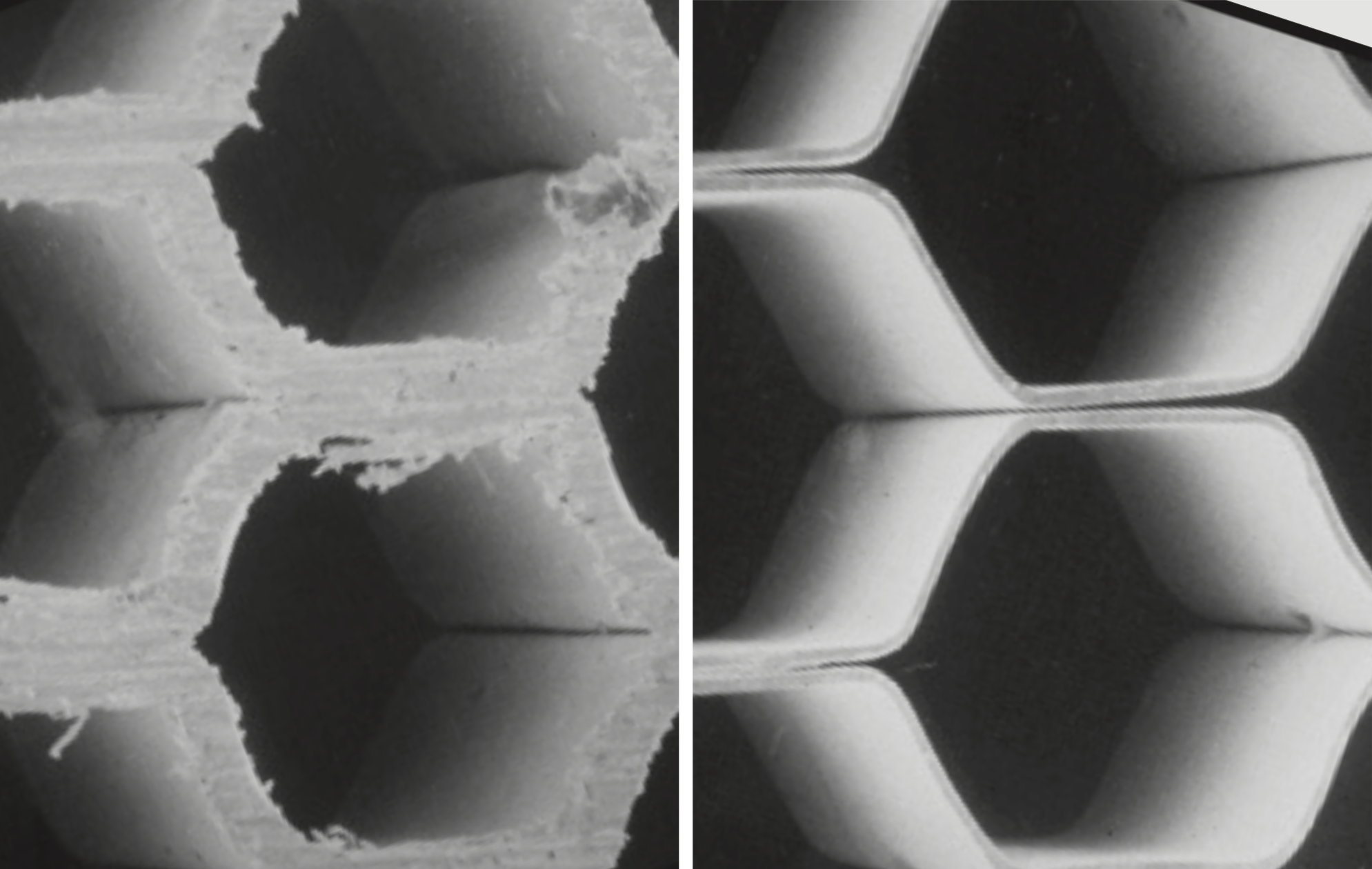
A typical electropolishing installation is similar in appearance to an electroplating line. A power source converts AC current to DC at low voltages. A tank fabricated from plastic or lead-lined tanks is commonly used to hold the chemical bath. A series of lead, copper or stainless steel cathode plates are lowered into the bath, to the negative (-) side of the power source. A part or group of parts is fixed to a rack made of titanium, copper or bronze. That rack in turn is coupled to the positive (+) side of the power source.
The workpiece is thus connected to the positive (anodic) terminal, while the negative (cathodic) terminal is connected to a suit- able conductor. Both positive and negative terminals are submerged in the electrolyte, forming a complete electrical circuit. The current applied is direct (DC) current.
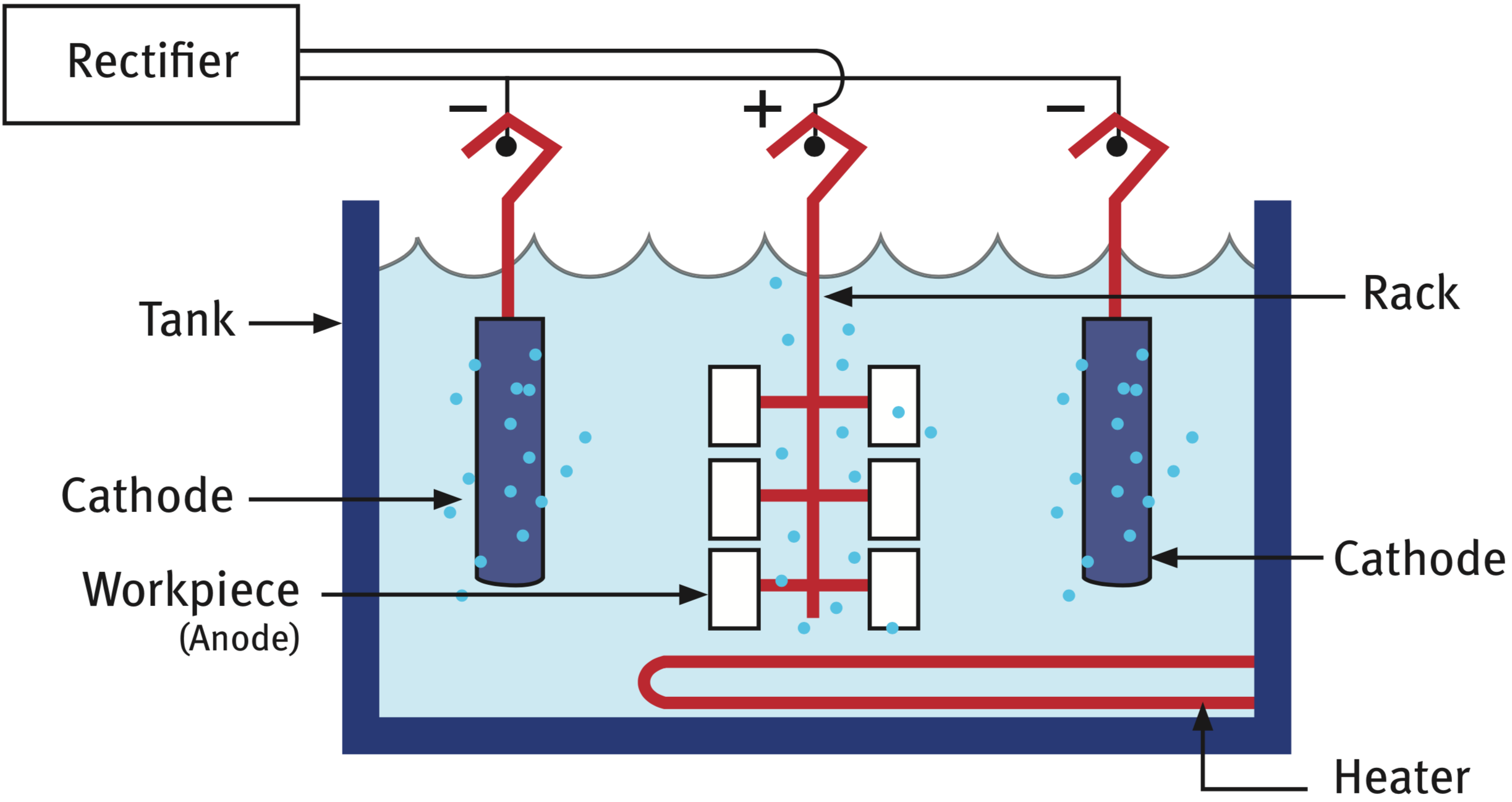
As the adjoining illustration shows, the metal part is charged positive (anodic) and immersed in the chemical bath. When current is applied, the electrolyte acts as a conductor (“tool”) to allow metal ions to be removed from the part. While the ions are drawn toward the cathode, the majority of the dissolved metals remain in solution. Some ions are deposited in sludge form on the cathodes, which require regular cleaning for efficiency. Gassing, in the form of oxygen, occurs at the metal surface, furthering the electrolytic action.
The quantity of metal removed from the workpiece is proportional to the current applied, the efficiency of the electrolyte and the exposure time. In the course of electropolishing, burrs and other projections become areas of very high current density and are preferentially eroded. The workpiece process parameters are set to control the amount of metal removed, so dimensional tolerances are maintained.
In the case of stainless steel, the various elements, which make up the alloy, are removed at different rates. Iron and nickel atoms are more easily extracted from the crystal lattice than are chromium atoms. The electropolishing process removes the nickel and the iron preferentially, leaving a surface rich in chromium. This phenomenon accelerates and improves the passivation of electropolished surfaces[2].
The fact that electropolishing is a non-distortion process is often overlooked. Electropolished parts are neither subject to mechanical nor thermal stress from polishing media, nor are they impinged or tumbled [4].
The results can be reproduced with a high degree of precision, so components with tight tolerances can also be treated safely 2.
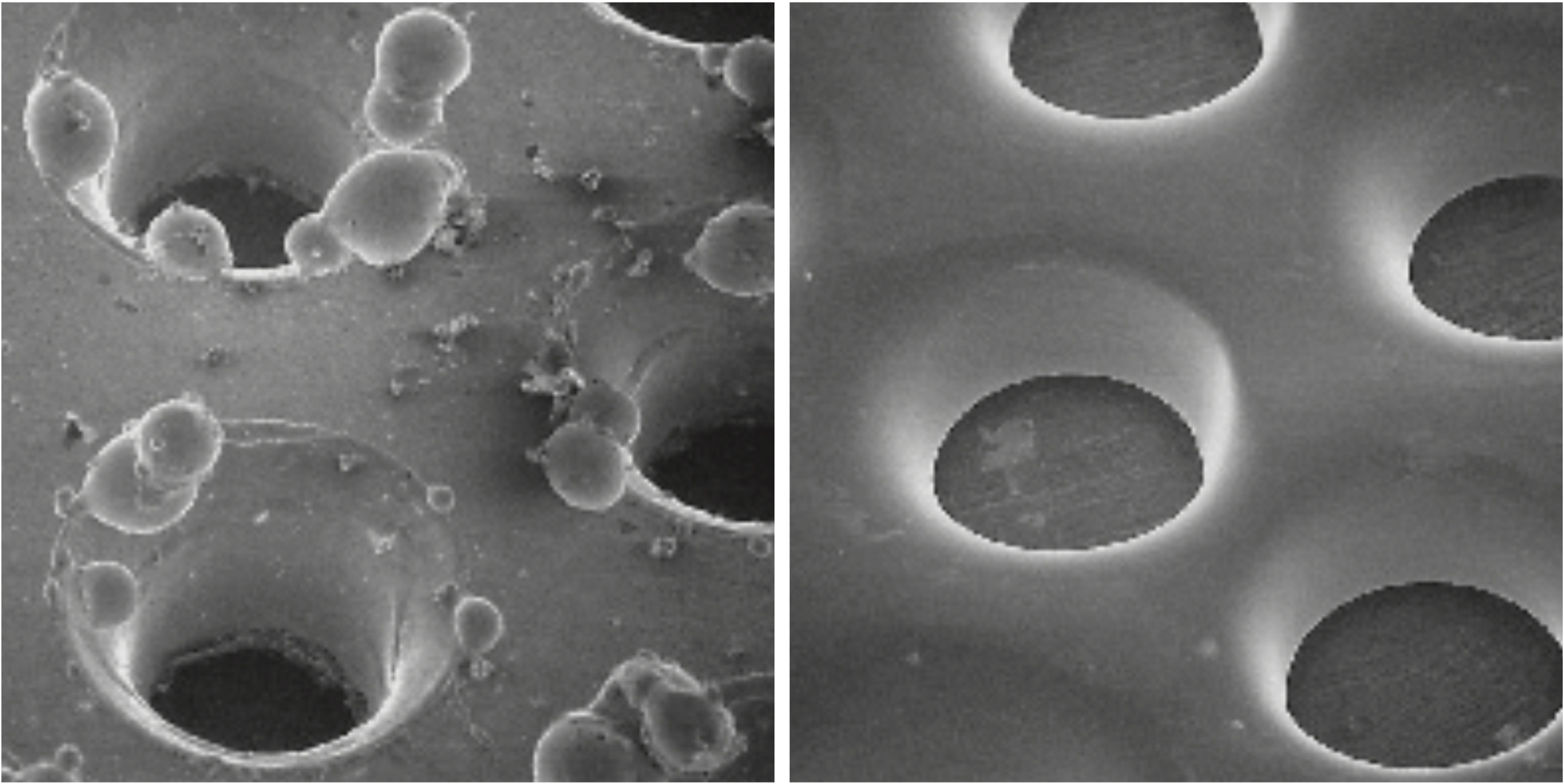
2 Given proper process control and procedures, there are no safety hazards, if competent electropolishing contractors are employed who ensure that efficient ventilation systems are used during the process. These operators should also dispose of waste materials, including spent acids, using approved, safe practices.
3 Process steps
To obtain high-quality electropolished finishes on most stainless steel alloys, the work must be performed in three major operations [5]:
- Metal preparation: to remove surface oils, greases, oxides and other contaminants that interfere with the uniformity of electropolishing
- Electropolishing: to smooth, brighten and/or deburr the metal
- Post-treatment: to remove residual electrolyte and by-products of the electropolishing reaction and dry the metal to prevent staining.
Each of these major operations may involve several tank stations to achieve the desired result.
The following schematic diagram shows the typical flow chart:
| Electropolishing Process |
|---|
| METAL PREPARATION |
| Cleaning |
| ↓ |
| Rinsing |
| ↓ |
| Pickling |
| ↓ |
| Rinsing |
| ELEKTROPOLISHING |
| Elektropolishing |
| ↓ |
| Drag-out / Neutralisation |
| ↓ |
| Rinsing |
| POST-TREATMENT |
| Nitric acid treatment |
| ↓ |
| Rinsing |
| ↓ |
| Hot rinsing |
| ↓ |
| Drying |
3.1 Metal preparation
Metal preparation includes two steps: alkaline or solvent cleaning/degreasing, followed by pickling where heat oxides (welds) are present.
The purpose of cleaning in alkaline or solvent cleaners is to remove any oil, grease, shop dirt, fingerprints or similar films left on the parts after manufacture. Surface contaminants present on the parts during electropolishing can lower the quality of the resulting finish, which is particularly important for critical applications such as medical, pharmaceutical and semi-conductor products. once the parts are removed from the cleaner, care should be taken to avoid unnecessary contact with hands or the process equipment, as cleanliness should be considered one of the cardinal principles of all metal finishing operations. Improper or inadequate cleaning is a common cause of parts being rejected.
A rinse tank serves two primary functions: to remove the chemical residue from the previous operation, by dilution and to act as a barrier to prevent drag-in to the following operation.
Acid descaling/pickling removes light oxidation from processes such as cutting and eliminates alkaline film left by cleaning.
The principles of operation for the acid descale rinse are essentially the same as those for the alkaline cleanser rinse. The main difference is that since acidic solutions are generally much easier to remove by rinsing than are alkaline residues, lower flow rates and/or shorter rinsing times may often be used.
3.2 Electropolishing
During electropolishing, the metal is dissolved from the anodic electrode, passing into the solution to form a soluble salt of the metal. All components of stainless steel – iron, chromium and nickel – undergo this reaction simultaneously, producing a controlled smoothing of the surface. Several side reactions also occur, creating by-products that must be controlled to produce the highest possible quality of electropolishing.
A typical electropolishing solution consists of an equal volume mixture of 96% mass fraction sulphuric acid and 85% orthophosphoric acid. The operating conditions are as follows:
- current density: 5 A/dm2 to 25 A/dm2
- temperature: 40°C to 75°C
- time: 2 min to 20 min
- cathodes: stainless steel, copper, lead
The drag-out tank captures electropolishing solution from the previous operation. Stainless steel electrolytes normally require neutralisation with caustic soda (sodium hydroxide or lime milk) and produce relatively large volumes of precipitate. Specialist electropolishing companies ensure that environmental, health and safety standards are met.
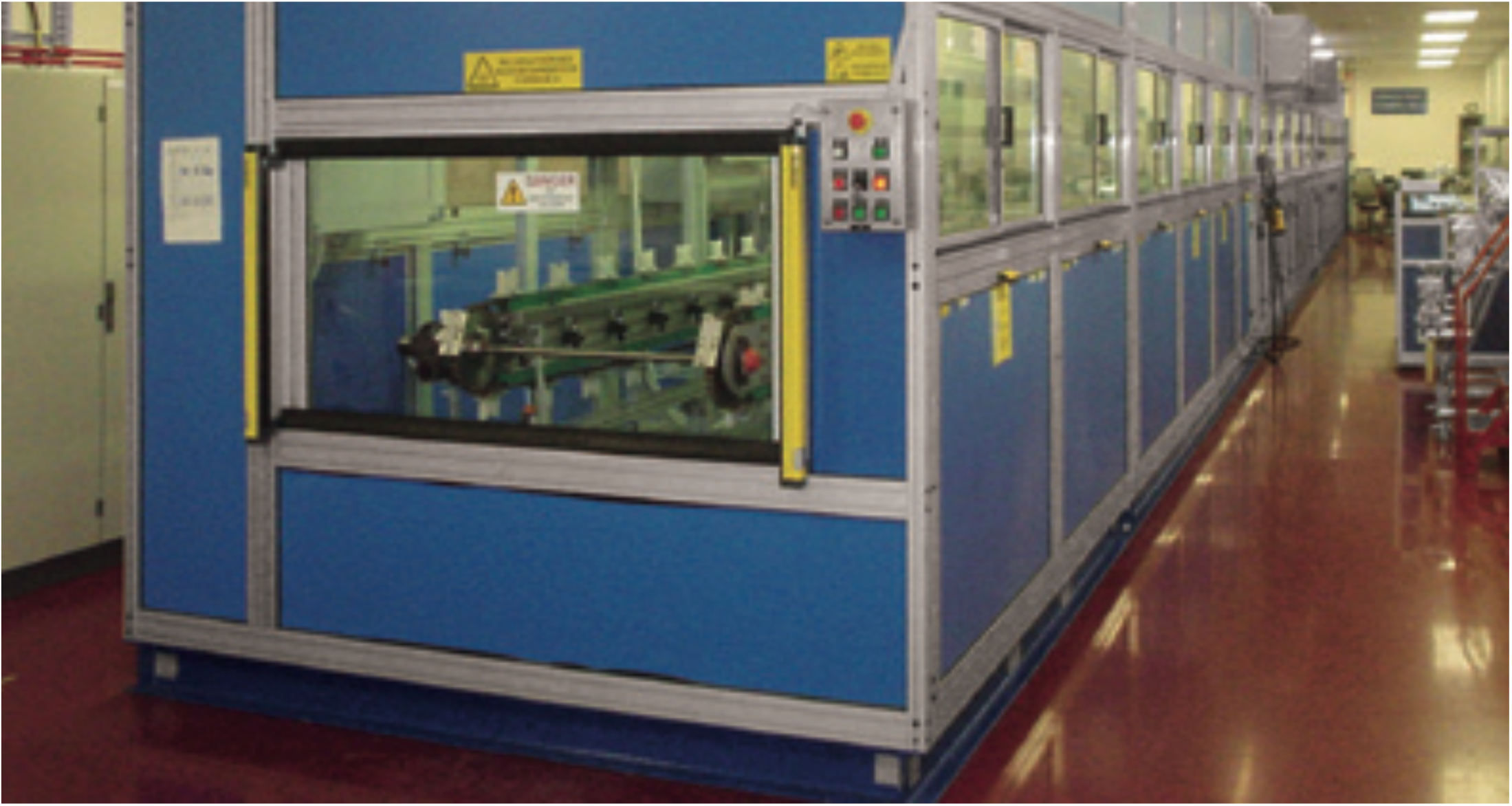
In rinsing, it must be taken into account that electropolishing solutions are viscous and do not mix readily with water. Care must be taken to avoid electropolishing solution drying on the parts, as residual acid would cause staining or etching during storage. For this reason, hot rinses used for drying purposes should only be used after any residual electrolyte has been thoroughly rinsed away.
3.3 Post-treatment
The purpose of nitric acid post-treatment for electropolishing is to dissolve the film of chemical by-products that forms as the electrochemical reactions take place. These by-products, which mainly consist of phosphates and sulfates of heavy metals, are difficult to remove by water rinsing alone. Thorough removal is crucial, however, to ensure that the surface remains consistent, corrosion resistant and hygienic during subsequent storage and use.
Residues of nitric-acid solutions can be removed with cold water, as they are more soluble in water than are alkaline residues.
There should be no traces of chemical on the components when they go into hot water, or the hot water will become progressively contaminated. The purpose of the hot-water rinse is also to raise the temperature of the metal sufficiently to cause flash drying of the parts before unracking.
Some types of parts will not dry completely after hot-water rinsing. Centrifugal dryers, heated air chambers and other types of drying stations may be needed to force rapid evaporation of residual moisture and prevent staining of the work.
4 Electropolishing vs. other surface-finishing techniques
Although the visual effect of electropolished, mechanically polished and electroplated material can be quite similar, their areas of application are fundamentally different.
4.1 Mechanical polishing
Mechanical grinding, polishing and buffing of stainless steel are typically used to produce attractive mirror-like results on consumer goods or decorative architectural parts. Mechanical polishing operations can be easy to perform at the workshop or on site 3 and during repair.
However, the processes can induce stress in the surface layer, which may cause their metallurgical properties to deteriorate and make them less suitable for particularly demanding environments. Mechanical treatment can also be labour intensive.
A mechanically polished metal surface involves microscopic scratches, strains, metal debris and embedded abrasives. In contrast, an electropolished surface is completely featureless. It reveals the original crystal structure of the metal without the distortion produced by the cold-working process that always accompanies mechanical finishing.
3 cf. VAN HECKE, Benoît, The Mechanical Finishing of Stainless Steel Decorative Surfaces, Luxembourg: Euro Inox, 2005 (Materials and Applications Series, Vol. 6).
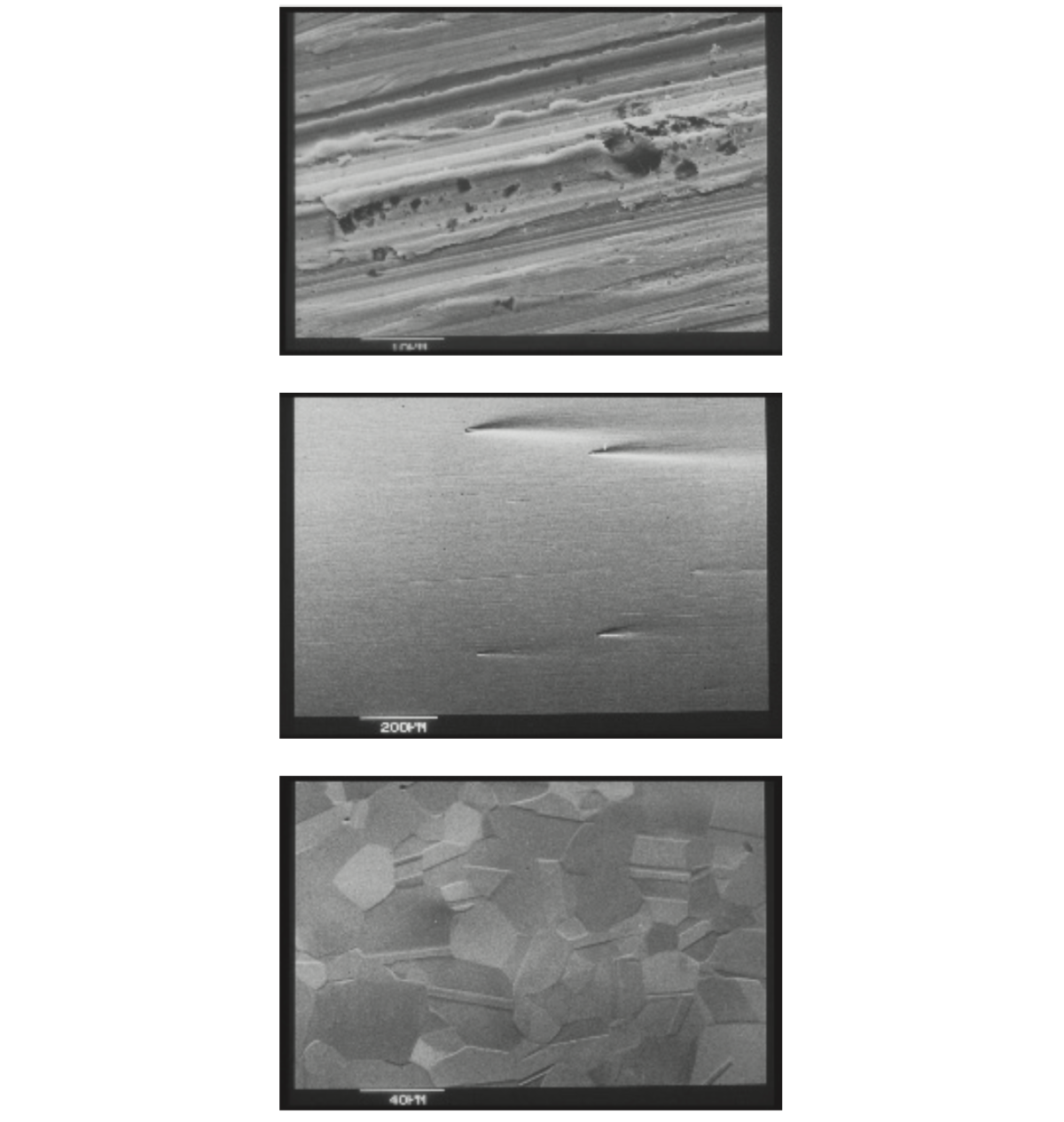
The difference between an electropolished part and a mechanically finished one is often not readily obvious to the eye, particularly if both are polished to the same roughness. The advantages of the finish produced by electropolishing become visible, however, when the surface is viewed under high magnification. In contrast, finishing processes using abrasives or other cutting or burnishing processes always distort the metal surface, regardless of how small the amount of work.
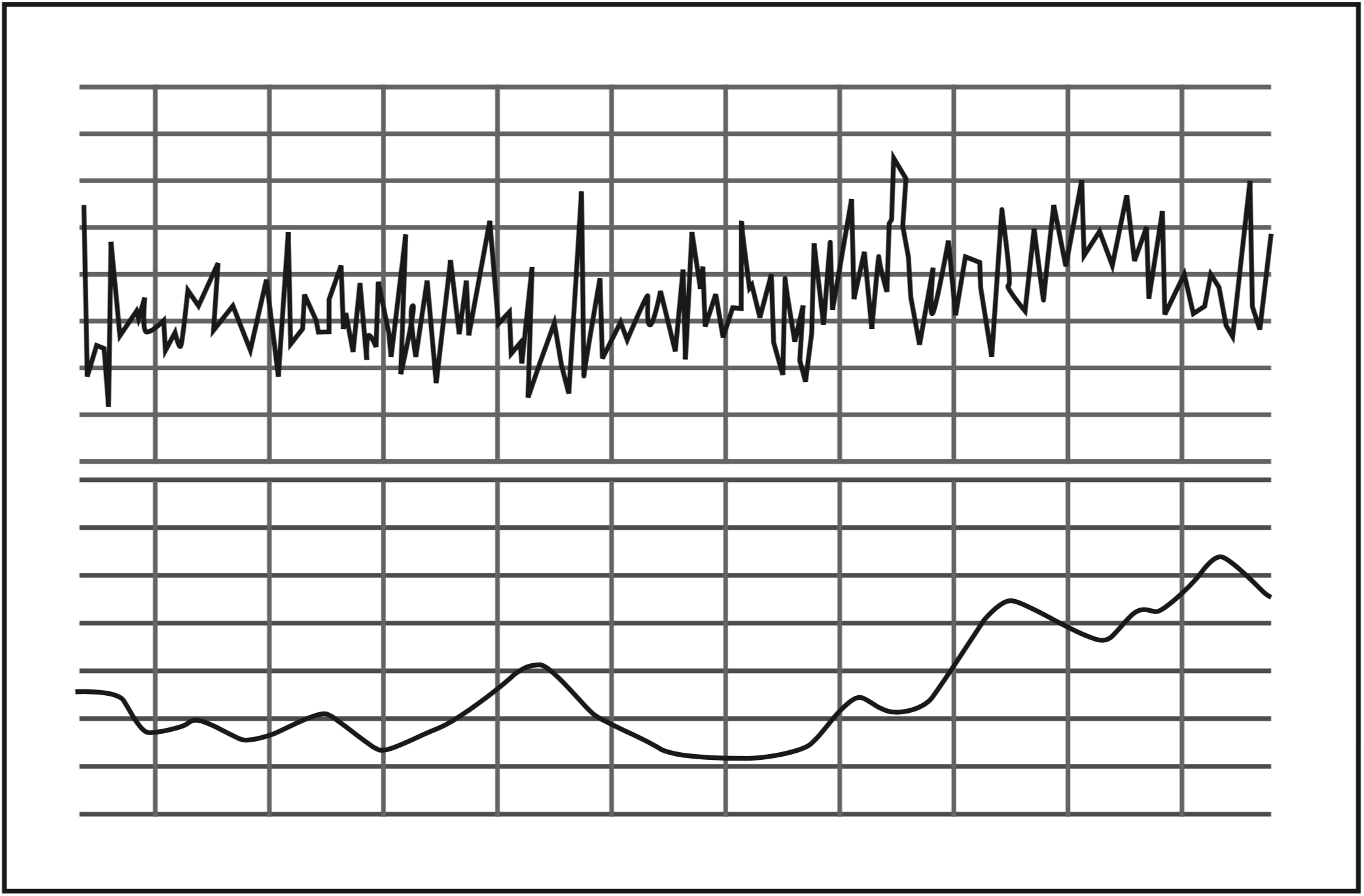
The differences are much more than simply topographical. The changes in material properties associated with cold working penetrate well below the surface and into the material. likewise, abrasives can become embedded in the surface. The mechanical strength of the surface is increased locally by the cold working that accompanies the induction of mechanical stress.
A smooth and defect-free surface can be obtained with electropolishing by choosing the optimum current density and temperature and appropriate bath configurations. The process is technically superior to mechanical polishing, because it does not contaminate the surface with any foreign material and the surface obtained by electropolishing is passive and corrosion resistant [6].
4.2 Electroplating
Highly reflective finishes can also be achieved by applying nickel and/or chromium plating to other materials, such as carbon steel. However, these added metallic layers are rarely microscopically flawless. Furthermore, they can wear or chip off and expose the base metal, which can subsequently corrode [3]. This is why chromium-plated carbon steel, for example, is not usually a suitable alternative to electropolished stainless steel.
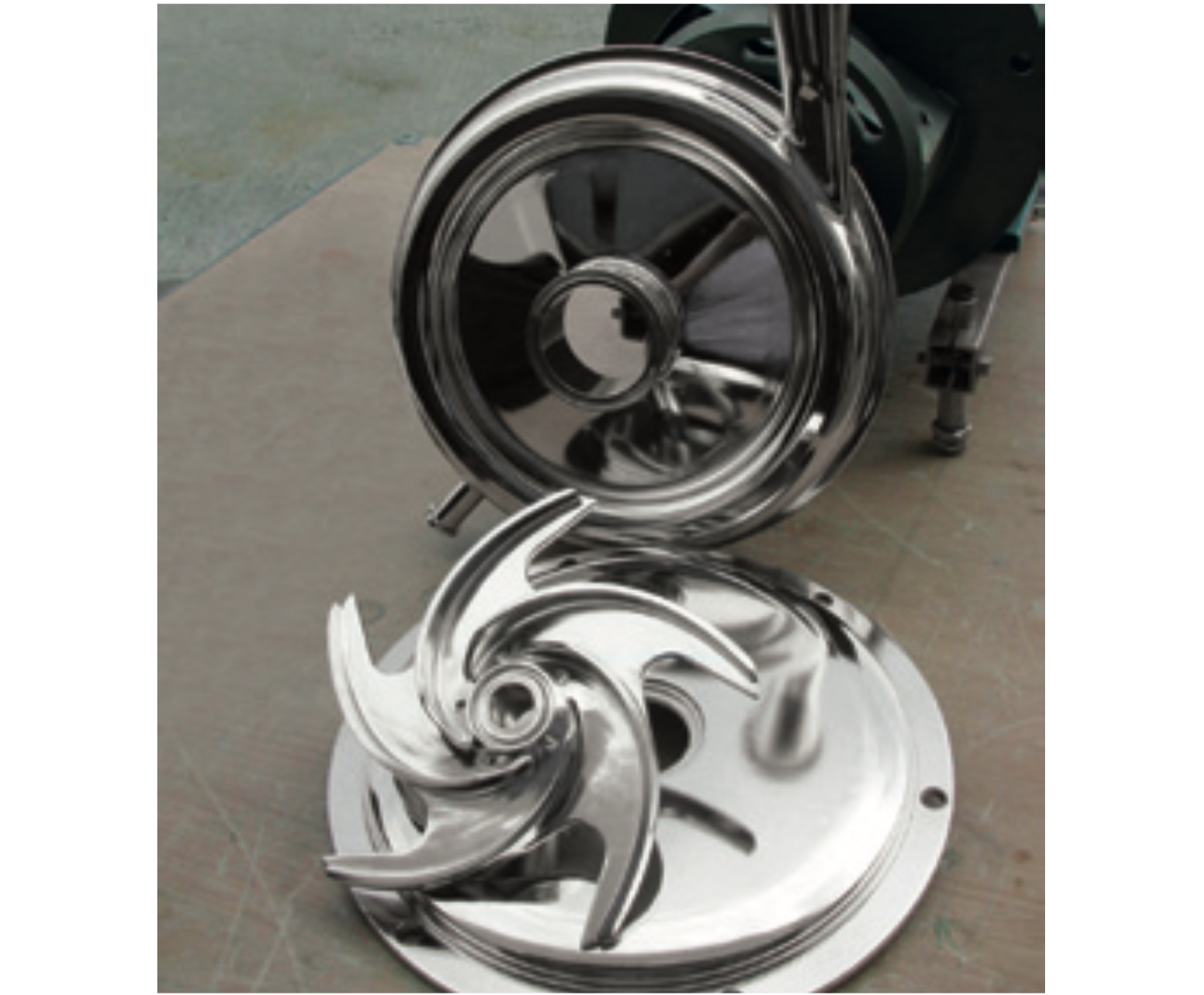
Electroplated glossy stainless steel can be found in automotive trim. Here, a chrome flash is applied to align the visual appearance of the stainless steel parts with that of the chromium-plated carbon steel parts. The plating does not add to the stainless steel’s corrosion resistance.
5 Specifying electropolished finishes
Electropolishing is preferred in many industries as a final finish for numerous metals because of its surface enhancement, its non-contaminating, non-particulating and non-stick qualities – or simply for decorative reasons. If the goal is an aesthetically pleasing finish, high-quality electropolishing can usually be judged by visual inspection. A microscopic evaluation of the surface is necessary, however, where the highest grade of finish is required and it is imperative that the surface condition be documented for future evaluation.
For example, a buffed surface (such as No. 8 super-mirror finish) may look exactly like an electropolished surface to the uneducated eye. They can yield the same surface-finish profilometer readings (Ra – roughness average 4 or RMS – Root Mean Square). Photomicrographs of the two surfaces will, however, show a substantial difference. The electropolished surface will be seen as featureless while, on the buffed surface some microscopic scratches, as well as embedded abrasives and buffing compounds, will be visible.
Roughness measurements have no real bearing on how easily an electropolished surface can be cleaned after use or on its non-contaminating, non-particulating or non-sticking properties [1].
The required appearance – for example, bright or dull – should be specified by the purchaser. Unless otherwise specified, a bright lustre is usually considered acceptable. Alternatively, samples showing the required finish or range of finish are supplied by or approved by the purchaser. When required, the base material may be subjected to mechanical grinding and buffing before electropolishing, to yield the desired final surface characteristics [7].
Where specified, the significant surface of the article to be smoothed and passivated by electropolishing must be free of clearly visible defects such as pits, roughness, striations or discolouration, examined with normal eyesight at a distance of approximately 0.5 m [8].
Stabilised stainless steel grades, like 1.4541 or 1.4571 are not used for electropolished applications.
Note: Defects in the surface of the base material such as scratches, porosity or inclusions, can adversely affect the appearance and performance of the article.
4 Ra is het rekenkundig gemiddelde van de ruwheidswaarden, gemeten op een gedeelte met een standaardlengte.
| Information to be supplied to the electropolishing contractor |
|---|
| - The number of the standard specifying electropolishing [8], the alloy designation number and the test method(s) to be used to evaluate the article |
| - The appearance required. Alternatively, a sample showing the required finish is supplied by or approved by the purchaser. |
| - Those areas on the article where electrical contact is acceptable. |
| - The dimensional tolerances, if any, to be stated in the ordering document 5. |
| - Any requirement for passivation testing 6? |
| - Any requirement for the provision of a test report? |
5 Typically, 5 to 10 μm of metal are removed from the surface during electropolishing. However, up to 50 μm may be removed for additional smoothing. Greater amounts will be removed from corners and edges (i.e. areas of high current density) unless shields and/or auxiliary cathodes are used.
6 Further information is available in ISO-15730 or ASTM-B912.
6 Typical applications
Piping and tubing
In recent years, electropolishing has been shown to provide the ultimate inner- and outer-diameter finish for piping and tubing. Electropolishing is necessary whenever non-contaminating, non-particulating and anti-fouling surfaces are required. In addition, both pipe and tubing benefit from the minimal-friction and maximum-purity aspects of electropolishing. Major beneficiaries of electropolished piping and tubing include the petrochemical, nuclear, pharmaceutical, semi-conductor and food and beverage industries.
Medical Applications
The medical field has benefited from electropolishing for many years. All hospital, medical and surgical equipment (scalpels, clamps, saws, coronary, bone and joint implants, prosthetic devices, etc.) should be electropolished to facilitate cleaning and achieve low contamination levels. Metal articles exposed to radiation and requiring regular decontamination are prime candidates for electropolishing.
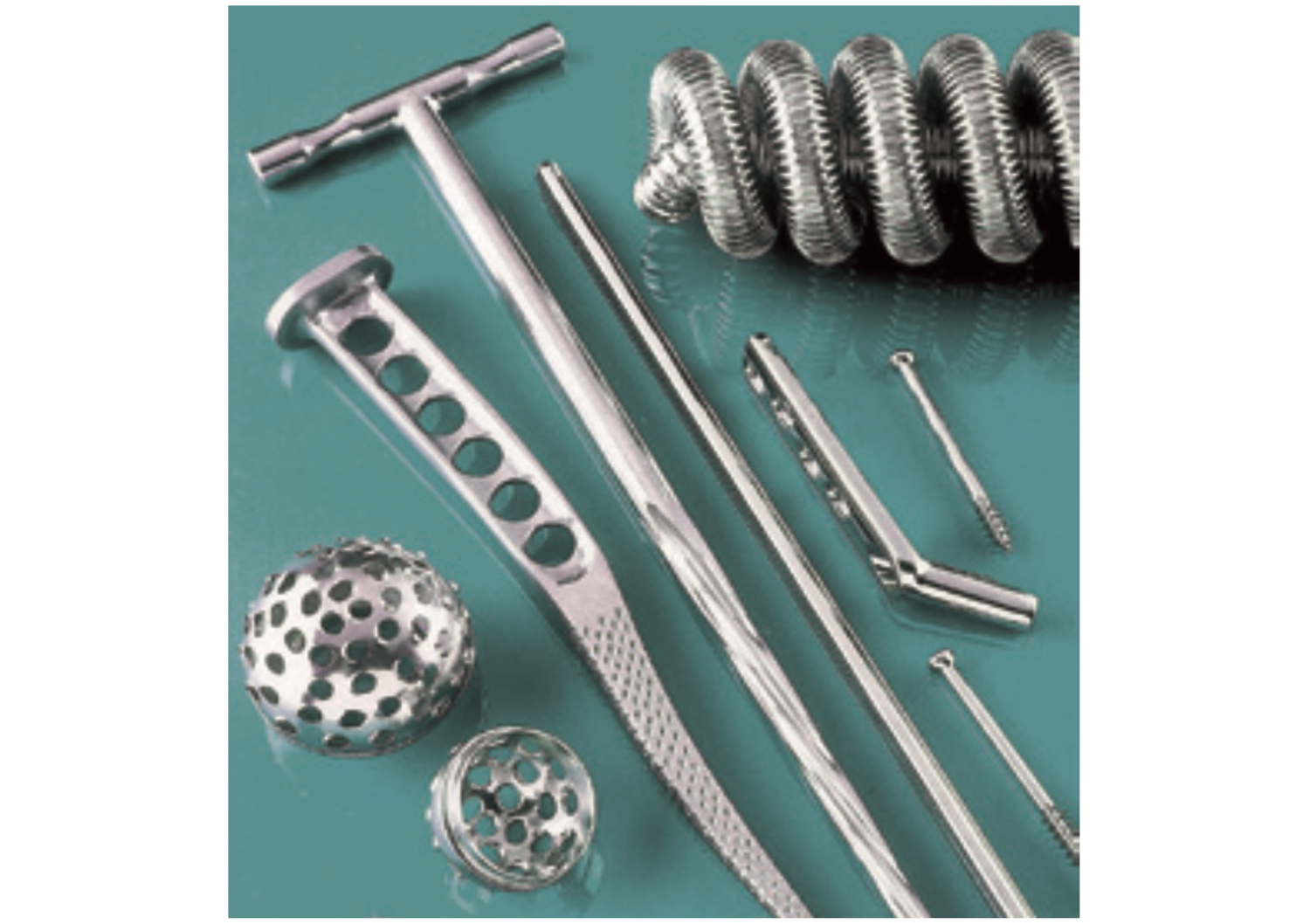
Semi-conductor manufacturing
Clean rooms in semi-conductor manufacturing require non-contaminating and non-particulating surfaces. An electropolished finish is the ultimate finish for metal components in a clean room, including tables, chairs, equipment consoles, gas and fluid distribution systems, waste containers, light fixtures, exposed electrical conduit and outlet boxes, vacuum chambers and manufacturing and processing equipment.
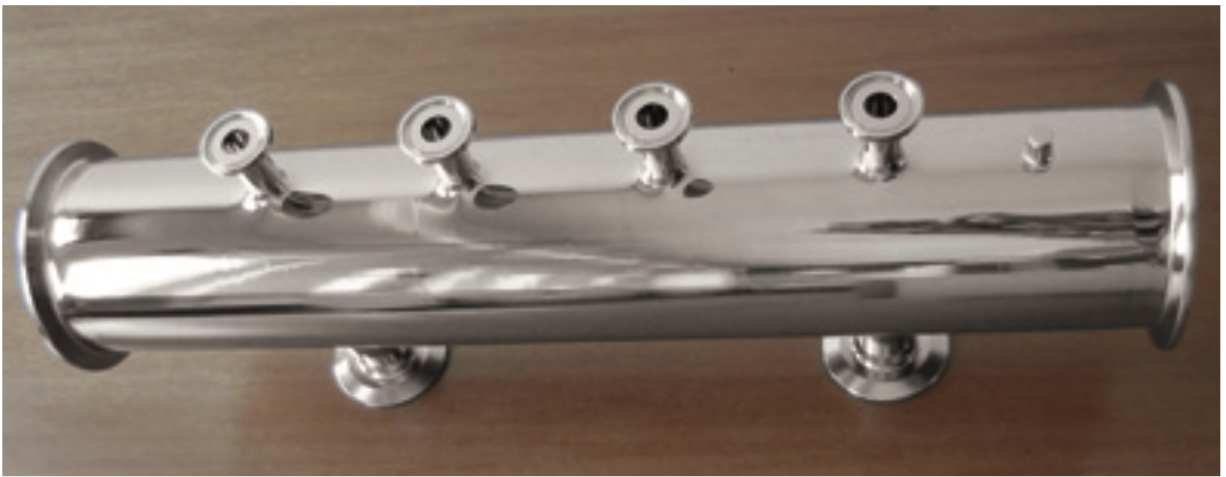
Pharmaceutical processing
Like semi-conductor manufacturers, pharmaceutical companies insist on super-clean metal surfaces. Today, the inside surfaces of pharmaceutical mixers, dry-product delivery systems, filters, strainers, vessels, dryers, choppers, cooling coils, plate coils, heat exchangers and other important hardware are all electropolished. For microbiological or other contamination problems, electropolishing offers the ultimate solution for stainless steel pharmaceutical components.
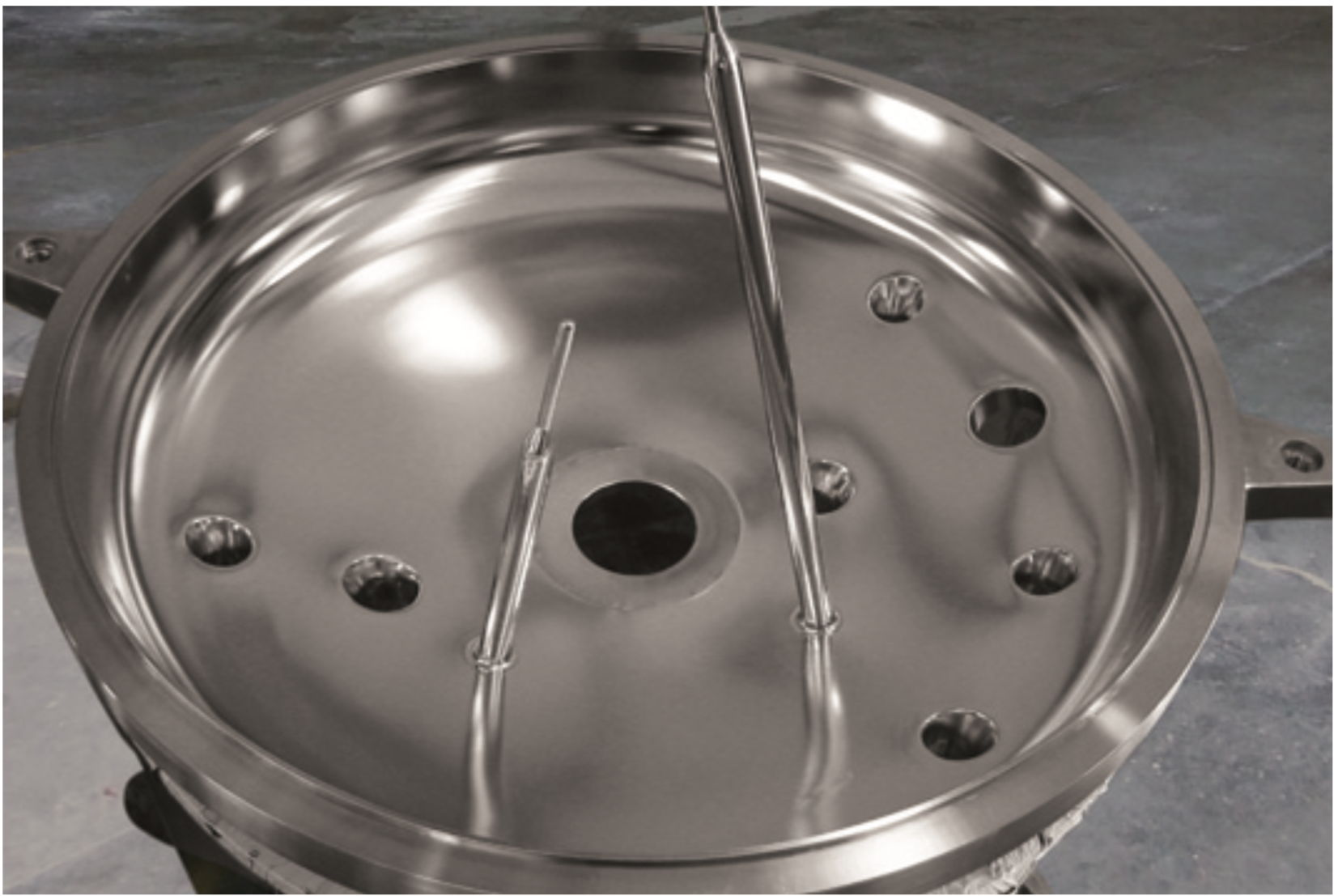
Energy exploration
The energy-exploration industry is a new customer for electropolishing. An expanding array of down-hole equipment is electropolished, mainly for super-passivation against sour gas attack. In addition, many off-shore rig components, including piping, pumps, valves, condensers and thermo wells, are electropolished for protection against salt air and water.
Food and beverage processing
Electropolishing provides the smooth, easycleaning and cosmetically pleasing surfaces demanded by this industry, coupled with unmatched non-contamination and sanitary qualities. The process reduces oxidation and contamination of stainless steel components used in kitchen, dairy and automatic food-processing equipment. overall, a perfectly clean surface is produced by electropolishing, offering maximum resistance to the build-up of bacteria and product particles.
Water treatment
The water treatment and distillation industries employ electropolishing to improve the corrosion resistance of stainless steel components and reduce the microbiological contamination that can accumulate within these systems. Components commonly electropolished in the water treatment and distillation industry include filters, screens and strainers, pumps and valves, condensers and piping.
Paper mills
Paper slurry-pipe systems and head boxes are two of the many electropolishing applications in the paper-mill business.
Public places
As electropolishing minimises surface micro-roughness and significantly reduces the adherence of dirt, it facilitates the removal of graffiti on stainless steel surfaces.
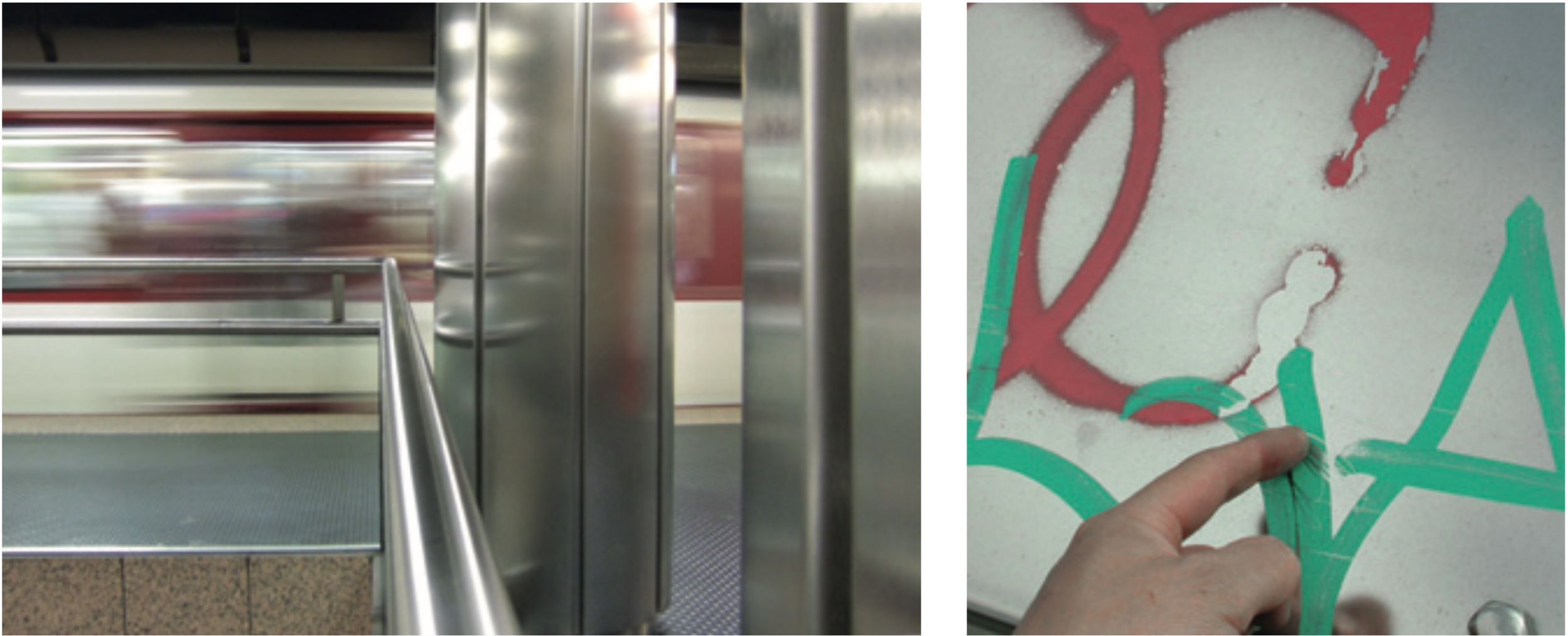
7 Glossary
activation
elimination of a passive surface condition
auxiliary cathode
a cathode so placed as to divert to itself some portion of the current from parts of the work that otherwise receive too high a current density
bright finish
a finish with a uniform, smooth surface of high reflectivity
buffing
mopping
smoothing of a surface by means of a rotating flexible wheel to the surface of which fine, abrasive particles are applied in suspension in a liquid, in the form of a paste or grease stick
NOTE: A mopped or buffed surface is char- acterised as semi-bright to mirror-bright, without pronounced line patterns on the surface.
burnishing
smoothing the surface by rubbing, essentially under pressure, rather than by removing the surface layer
cleaning
removing foreign materials such as oxides, scales, oil, etc. from the surface
-
acid cleaning
cleaning (as above) by means of acid solutions -
alkaline cleaning
cleaning (as above) by means of alkaline solutions -
anodic cleaning reverse cleaning (U.S.)
electrolytic cleaning in which the work- piece to be cleaned is the anode of the cell -
electrolytic cleaning
cleaning in which direct current is passed through the solution, the workpiece to be cleaned being one of the electrodes
current density
the ratio of the current on a surface of an electrode to the area of that surface
NOTE: Current density is often expressed in amperes per square decimetre (A/dm2)
deburring
removing sharp edges and burrs by mechanical, chemical or electrochemical means
degreasing
removing grease or oil from a surface
drag-in
liquid carried into a solution by the objects introduced therein
drag-out
liquid carried out of a solution by the objects removed therefrom
dull finish
a finish essentially lacking both diffuse and specular reflectance
electrolytic solution
electrolyte
a conducting medium in which the flow of current is accompanied by movement of matter, being most often an aqueous solu- tion of acids, bases or dissolved salts of the metal that is to be deposited
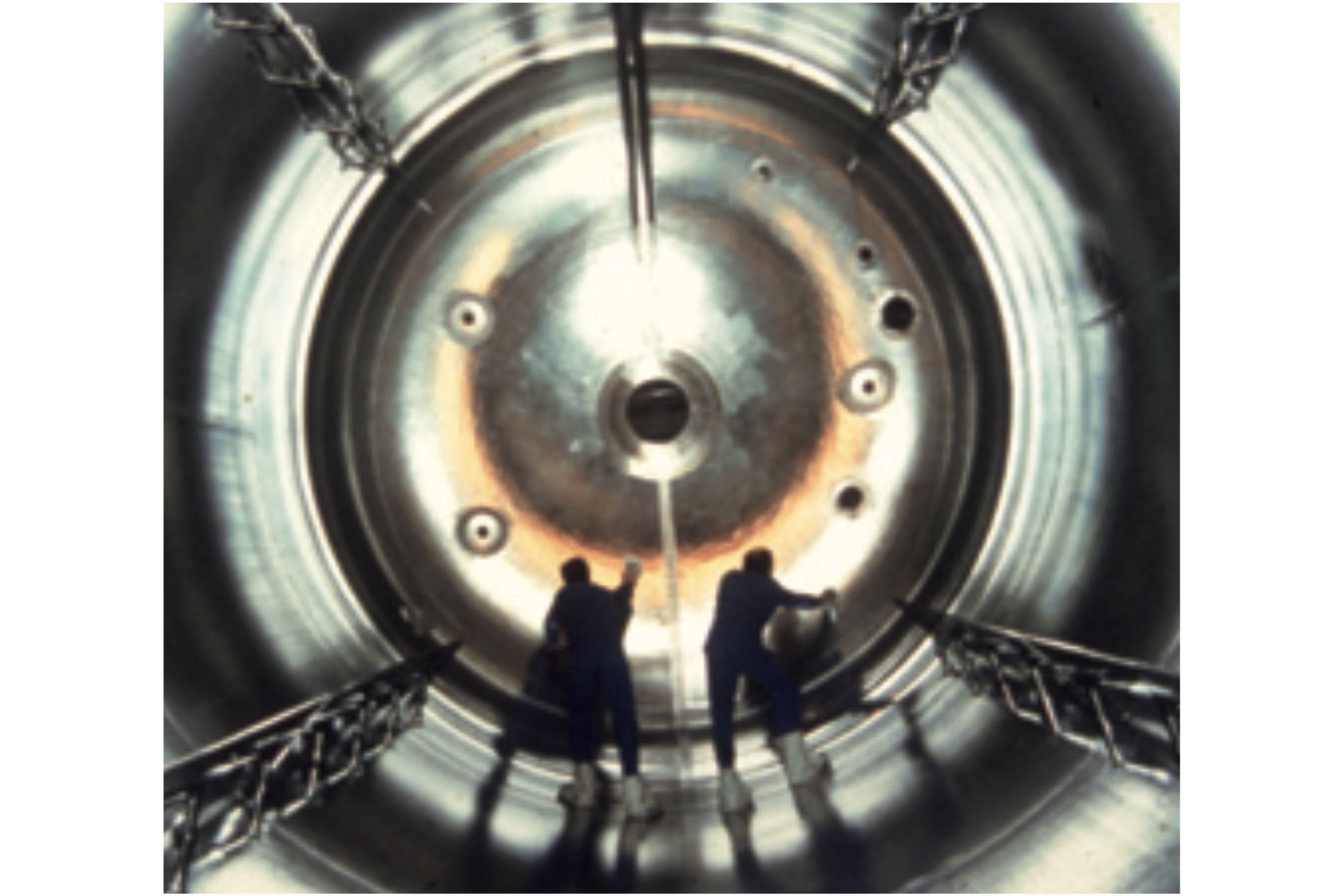
electroplating
electrodeposition
deposing an adherent coating of a metal or an alloy upon a substrate by electrolysis, to secure a surface with properties or dimensions different from those of the base metal
electropolishing
improving the surface smoothness and brightness of a metal surface by making it anodic in an appropriate solution
etch
to unevenly dissolve a part of the surface of a metal
finish
the appearance of the coating or base material (cf. bright finish, dull finish, matt finish, satin finish)
gassing
the evolution of gases from the electrode(s) during electrolysis
grinding
polishing
removing material from the surface of a workpiece by means of abrasives contained in or bonded to a rigid or flexible holder, grinding usually being the first step in polishing operations
matt finish
a uniform finish of fine texture, virtually without specular reflectivity
measurement area
the surface area that is examined for conformity to one or more specified requirements
passivating
imparting passivity to a metal surface or to an electrodeposited coating
pickling
removing oxides or other compounds from a metal surface by chemical or electrochemical action
polishing, mechanical
smoothing a metal surface by the action of abrasive particles attached by adhesive to the surface of wheels or endless belts, usually driven at high speed
rack
a frame for suspending and carrying current to articles during electropolishing and electroplating
scale
an adherent oxide coating, thicker than the superficial film and referred to as tarnish
surface treatment
a treatment to modify a surface
8 References
[1] www.delstar.com, ‘’Electropolishing, A User’s Guide to Applications, Quality Standards and Specifications’’, 2003
[2] http://www.kepcoinc.com/?page=serviceselectropolishing, kalamazoo Electropolishing company, ‘’What is Electropolishing?’’
[3] http://www.abccorporate.com, Allegheny Surface Technology, ‘’Electropolishing’’
[4] http://www.ableelectropolishing.com/electropolishing_workbook.pdf, Able Electropolishing, ‘’Looking for Solutions to Metal Surface Problems?’’
[5] http://www.electropolish.com/pubs/process_steps.pdf, ‘’The MCP System of Electropolishing, General Process Steps’’
[6] MOHAN, S., KANAGARAJ, D., VIJAYALAKSHMI, S., RENGANATHAN, N. G., ‘’Electropolishing of Stainless Steel – a Review’’, Trans IMF 79, No.4, 2001
[7] ASTM B 912-02 Standard Specification for Passivation of Stainless Steels Using Electropolishing
[8] ISO 15730: 2000 Metallic and other inorganic coatings – Electropolishing as a means of smoothing and passivating stainless steel